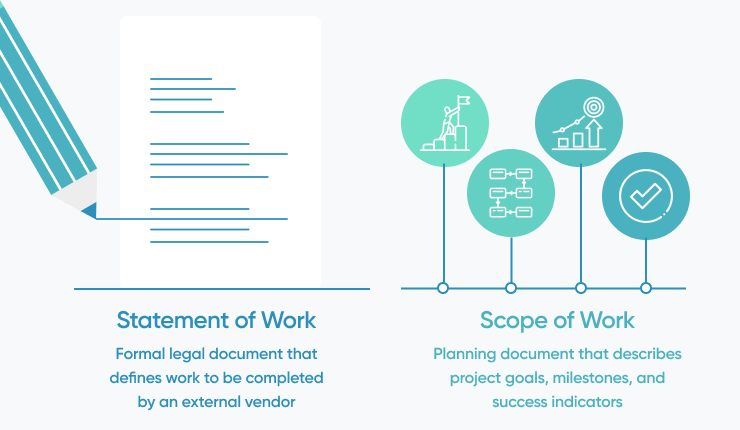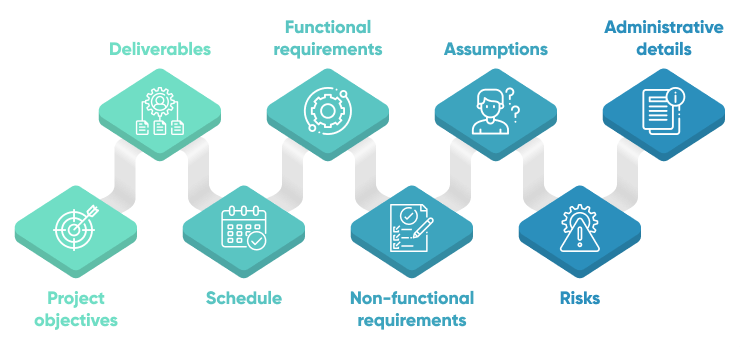Starting a new IT project comes with a lot of challenges. According to the Project Management Institute, IT projects, on average, end up 45% over budget while delivering 56% less value than expected.
One of the best ways to avoid these project pitfalls is to create a detailed and comprehensive scope of work (SOW) for your software development project. But what exactly is a SOW? And how do you write one?
In this article, we'll answer those questions and give you a software development SOW template you can use for your next project. By the end of this article, you'll have a better understanding of what a software development SOW is and how to create one that will set your project up for success.
What is a software development Scope of Work?
A software development scope of work (SOW) is a document that provides a detailed description of the work to be completed as part of a software development project.
SOWs can be used by product teams, IT teams, marketing organizations and more to ensure that the project scope is well thought-through and agreed upon before work begins. Depending on your team’s circumstances, you may find an SOW useful for:
- Internal use. Written as part of an internal documentation or project scoping process, an SOW can help to ensure that all project stakeholders agree on the work to be completed, allow the team to better estimate the timeline for work to be completed, as well as help to identify potential risks and dependencies before project kick off.
- Request for proposal (RFP). If you are hiring an external software development vendor or software development company, you’ll want to draw up an RFP that should include an SOW document that outlines project scope and other details that will help the vendor provide a cost and schedule estimate.
- Contract appendix. Further along in the process of hiring a software development vendor, you’ll draw up a contract that should include project scope details in the appendix. This could be a formal SOW document or sections of your SOW that are relevant for your vendor relationship.
Note: when a scope of work is part of a legally-binding contract, it is often referred to as a software development statement of work.
Who should write an SOW?
The SOW should be written by the party who will be responsible for delivering the project outputs. This could be the project manager, a consultant, startup founder, CTO or other technology leader who is spearheading the software development project.

If the SOW is for a complex project, it is often best to have it written by a consultant with experience in the relevant field. This ensures that all the necessary elements are included and that the SOW is fit for its purpose. However, if the project is relatively straightforward, it may be possible for the project manager to write the SOW.
In any case, it is important to involve all relevant stakeholders in the SOW-writing process, as they will be able to provide valuable input and feedback. Once the SOW is completed, it should be reviewed and approved by all stakeholders before being finalized and sent to any relevant external vendors.
Why do you need an SOW for software development projects?
You may be wondering why you need a scope of work at all. When you’re undertaking a complex, costly project, it’s critical to have all stakeholders and upper management on board. One of the best ways to achieve this is via an SOW that provides a comprehensive, well-documented summary of the project at hand.
Furthermore, an SOW can help you ensure all details are taken into consideration, so you can keep your project under budget and on schedule. Additionally, when working with an external vendor, you’ll need a legally-binding document you can hold your vendor accountable to. This is a great use for an SOW (or software development statement of work).
All things considered, an SOW is a necessary and critical document for any software development project, especially those which are complex, costly, or involve multiple teams or external vendors. When in doubt, assume you need an SOW!
An SOW will help to:
- Ensure that all parties understand and agree on the work that needs to be completed
- Provide clarity on the project's objectives and deliverables
- Establish expectations for the project timeline, budget, and resources
- Define the roles and responsibilities of each party involved in the project
- Document the agreed-upon processes and procedures for the project
Software development statement of work vs scope of work

A statement of work and scope of work are often confused - and for good reason! They are both typically abbreviated as “SOW.” So, what’s the deal?
While there is a lot of overlap between the two - and even a lot of folks in the industry who use the terms interchangeably - they are in fact different things. Let’s break it down:
Scope of Work:
- Business document that outlines project details such as project milestones, project success indicators, and risks
- Can be used to help teams �“scope out” the work to be done and ensure they have thoroughly evaluated risks, assumptions, and project requirements before beginning development
- Can be used to help communicate project details to a potential outsourcing vendor
Statement of Work:
- Formal legal document that defined work to be completed by an external vendor
- Can be used to establish a detailed, binding commitment of work on a development project
To help satisfy the needs of most teams, the scope of work template below covers everything you would need for a traditional scope of work as well as some places to fill in more details that would be necessary if you’re working with an external vendor or are being asked to create a more formal software development statement of work.
Software Scope of Work template

A software development scope of work is a valuable document for any team embarking on a new software development project. But, if you’ve never drafted one, it can feel overwhelming! That’s why we are sharing this SOW template to help you get started. Let’s start with the first section of any SOW document: project objectives.
Project objectives
Detail out your high-level software development project goals. Provide enough context that would allow for someone not familiar with the project to understand what you are developing and why. Be sure to paint a picture of what the end product will look like.
Questions to consider:
- What are you trying to achieve?
- What are your project objectives?
- What business problems are you trying to solve?
Example:
As a private equity real estate firm, we need to collect, process, and analyze significant amounts of data gathered from the real estate market. We would like to build a custom real estate management software platform that allows our in-house real estate investors to view real-time data pulled from various external sites and internally-held data warehouses, so they can make better investment decisions.
The end product will be a user-friendly, flexible web application that supports backend data processing and front end data visualization.
Deliverables
It’s time to think about what you are expecting the outputs of the project to be. Think about this as a way to expand upon your project goals and define what success would look like for your software development project. Depending on the size of your project, you can consider breaking down the deliverables into project phases, sometimes referred to as a work breakdown structure (WBS).
Questions to consider:
- What work breakdown structure makes the most sense for your project?
- Have you considered all relevant key performance indicators?
- Has everything been detailed out sufficiently to avoid scope creep?
- Have you outlined all relevant extensive and comprehensive tasks?
The level of detail you provide in this section of the SOW document will depend on your project. If you are hiring software developers to do the work for you, you’ll want to keep the deliverables specific but non-technical, as the software developers will help you define the specifics of how the deliverables will be achieved.
Example:
The project will be broken down into two phases with the following deliverables:
Project Phase 1: Build Back-end Big Data System
- Engine that analyzes real estate market data at scale
- Pre-processing of internal statistical data
- Processing of external geospatial data sets
- Integration with existing data storage system
Project Phase 2: Build Data Visualization Platform
- User-friendly web application that provides access to data on demand
- Flexible visualization tools that provide geospatial data maps
- Report generation functionality
Schedule
After you have defined your project deliverables, you need to lay out the project schedule. This is key for any project planning document! Start by considering the high-level project duration, then break down your project into distinct tasks (or use the phases from above) and set the start and end dates for each.
Questions to consider:
- What dependencies exist for individual tasks?
- Who will be responsible for each task?
- What development process will you be using (such as Agile)?
- How will project delays or missed deadlines be handled?
Example:
| Task description | Responsible Party | Schedule | |
| 1 | Vendor Evaluation & Hiring | Internal | Start date: March 1 End date: April 15 |
| 2 | Build Back-end Big Data System | Vendor | Start date: April 30 End date: June 15 |
| 3 | Build Data Visualization Platform | Vendor | Start date: June 15 End date: Aug 1 |
| 4 | Testing & Deployment | Joint | Start date: Aug 2 End date: Aug 15 |
Functional requirements
Next up in your SOW document should be a list of all functional requirements for your software project. Functional requirements should describe what a software system is supposed to do (i.e. how it should function). The end result of functional requirements will be the features of your application, website, or product.
Should include requirements related to:
- Administrative functions and permissions
- Enough specificity for functionality implementation to begin
- User functionality and operations for every screen
- All workflows performed by the application
- Consideration for all relevant hardware and software restrictions
Depending on the complexity of your project, you might want to break down your functional requirements by screen, application area, persona, or by some other means to make them more understandable.
Example:
| Functional Requirement | |
| 1 | The system must allow users to change their password. |
| 2 | The system must allow users to filter data by location (city, zip code, state, etc.). |
| 3 | The system must allow users to generate a report and have it sent to them via email. |
| … |
Non-functional requirements
Non-functional requirements should describe how a software system works. The end result of non-functional requirements will be product attributes that may be more “behind the curtain,” but are just as important as functional requirements.
Should include requirements related to:
- Security. Will you be storing PII or other sensitive data? Does your company have any specific security standards that should be adhered to?
- Capacity. What kind of data storage requirements do you have? Do you expect your needs to change over time?
- Compatibility. What are the minimum hardware requirements? What are the technical limitations that should be considered?
- Reliability. Do users need 24/7 access? What are the acceptable down times for your system?
- Scalability. What is the maximum load that should be able to be handled? Consider both data and user traffic.
- Usability. Are there specific UX standards that should be followed? Consider also ADA accessibility.
Example:
| Non-functional Requirement | |
| 1 | Reports should be generated in under 3 minutes. |
| 2 | The application should be able to handle at least 10,000 concurrent users. |
| 3 | The system must meet Web Content Accessibility Guidelines WCAG 2.1. |
| … |
Assumptions
Everyone working on a software development project will have a set of assumptions about it. Problems come in when the assumptions aren’t acknowledged. To help ensure all stakeholders - internal and external - are aligned, document all assumptions that are being made about the project at hand.
Questions to consider:
- What assumptions are you making about hosting, deployment, or post-launch support?
- What assumptions are you making about technology stacks or compatibility?
- What assumptions are you making about approvals required in order to move from one phase of the project to the next?
Example:
| Assumption | |
| 1 | The vendor will provide on-demand support and maintenance for 12 months. |
| 2 | The system will replace our current, legacy system within 3 months of launch. |
| 3 | The project lead will have final say on approving design decisions for the front-end system. |
| … |
Risks
Every IT and software development project will come with risks. To help all levels of management understand what could Make sure to include all stakeholders in documenting the relevant risks for their area of expertise.
Should include:
- Value risks - not providing the required value to internal stakeholders or external customers to make the project successful or profitable
- Usability risks - potential problems with the usability of the software system
- Feasibility risk - project failure due to technical or staffing shortcomings
Example:
| Risk | Risk Likelihood | Implication of risk | |
| 1 | Users find the system difficult to use and will simply choose to not use it. | Medium | Investment in software development does not yield expected business value. |
| 2 | Internal staff unable to provide adequate project management support. | Low | Need to hire an external project manager or delay the project. |
| … |
Administrative details
In this final section of your SOW business document, you should outline any other relevant project or contractual specifics. If your SOW is meant to accompany or be included in an RFP, you may want to lay out your company’s standard payment terms or contract terms. You could also consider including details about how project management and status updates/reporting will be handled throughout the project.
In short, this is your catchall section for details that are specifically relevant to your software development project, your project management and process requirements, and how you intend to use your SOW.
Could include:
- Payment terms / payment model
- Standard company contract terms
- Reporting requirements
- Project management details
Tips for writing a Software Development SOW
Now that you’ve seen what a typical SOW looks like, let’s break down a few tips for drafting an SOW that can help you keep your project under budget and on schedule, regardless of its complexity:
- Keep it brief. While your SOW should include a sufficient amount of detail about your project scope to be valuable to all stakeholders, you should keep a lid on extraneous or irrelevant information.
- Create it early. An SOW should be created as early in the project as possible, ideally before a project is fully staffed and before a software developer or team of developers is brought in.
- Include stakeholders. When all stakeholders are brought to the table, they can provide a well-rounded perspective on the project and ensure the SOW meets the needs of all involved.
- Stay agile. The first draft of your SOW won’t be your last. As you engage with vendors and learn more about your project, adjust project deliverables, requirements, and schedules.
Software Development Scope of Work Template (Google Doc)
Ready to download your own Scope of Work Template?
- If you’re including your SOW as part of an RFP, use the Scope of Work Template (RFP)
- If you’re including your SOW as an appendix to a contract with a software development vendor, use the Scope of Work Template (Vendor Contract Appendix)
Need help with software development SOW?
At SoftKraft we provide Software Product Development Services. We take project ownership and responsibility for decisions that were taken during the development. Success of the project is the only metric that really matters to us.
Conclusion
A software development SOW is a valuable document for any team embarking on a new development project. It can help to ensure that all parties understand and agree on the work that needs to be completed, provide clarity on the project's objectives and deliverables, establish expectations for the project timeline, budget, and resources, and define the roles and responsibilities of each party involved in the project.
An SOW can certainly deliver teams substantial value, but the whole process of writing one can feel overwhelming. That’s why we have provided an SOW template to help drafting your next SOW a little easier.

![Software Development Scope of Work [Template, Tips & Tools]](/.netlify/images?url=_astro%2Fscope-of-work.Ck6RObRf.png)





